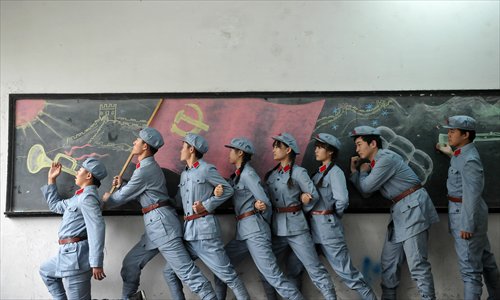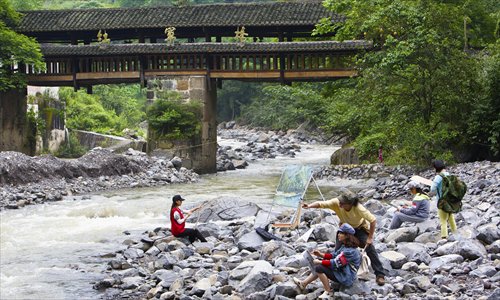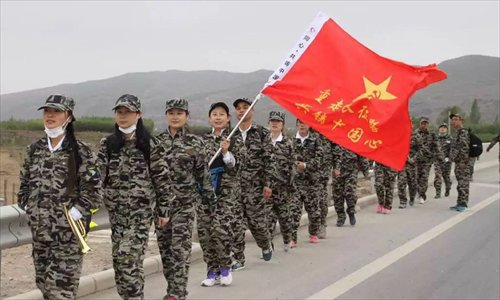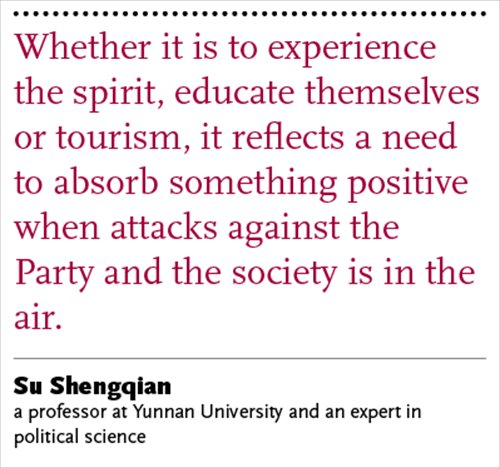Tourists retake the Long March to keep revolutionary spirit

Students at Liaocheng University pretend to be on the Long March. Photo: IC
Ji Jing, a girl that's about to graduate from college, just came back from an exhausting 100-kilometer hike in remote Northwest China in which she and her colleagues tried to recreate one of the most famous chapters in the Communist Party of China (CPC)'s revolutionary history.
During the journey, she and her colleagues hiked along the path on which Mao Zedong and the Red Army traveled during the Long March (1934-36) in the Ningxia Hui Autonomous Region. They carried national flags and Party flags, wore military-style camouflage uniforms and walked in a column, just like a group of marching soldiers.
To really have a taste of the hardship that the Long Marchers faced, Ji and her colleagues did not act like normal tourists that travel from scenic site to monument by bus and spend the day snapping photos. They took the trip seriously.
"Most colleagues' feet got blistered. Some felt it was unbearable. But eventually we all made it," Ji recounted.
"The Red Army persisted to the end in spite of the difficulty and danger. Through the hiking, I learned to be tough when I meet challenges in life. I should not give up easily," said Ji.
Climbing mountains and trudging through marshlands, her team walked in the footsteps of the Long Marchers despite their fatigue and hunger. As this year marks the 80th anniversary of the end of the Long March, some people are symbolically choosing to taste just a small part of the hardships faced by the country's founding fathers.
"I understand that even though I totally followed what the Red Army had experienced, I cannot feel what the circumstance was like at that time. I wanted to experience the process more in spirit," said Liu Zengxian, an art teacher at Southwest University in Chongqing who just finished a two-year trek along the Long March route by Jeep.

Liu Zengxian and his students paint pictures of a Long March site at the Red Army Bridge in Chongqing. Photo: Courtesy of Liu Zengxian
Picking up the spirit
Ji's company, which makes medicine, hopes its employees take in the spirit the Red Army showed on the Long March through the journey and build a "team of steel," according to Ji.
"Our manager said that now we are here, we should not just go through the motions but should experience the Red Army's spirit in our hearts," Ji told the Global Times.
Divided into nine groups, they covered almost all the route the Red Army trudged through in Ningxia. When they achieved their daily goal on May 13 after 13 hours of marching, eight of the "soldiers" had a fever. But the next morning, all the "soldiers" lined up on time to set out as if nothing happened. They were so exhausted, they had to hold each other up and limped to their destination.
The 100 kilometers, even though it was nothing compared to the real Long March, were bitter enough for Ji and her colleagues.
"Many colleagues cried on the last day when we shared our experiences along the way. We didn't expect that we could make it," Ji said, "We hope to persist with this spirit in our work and lives in the future."
Not all the people who want a taste of the Long March choose to actually march the route like Ji did. Some travel the whole route by car and just stop at key sites and learn the history through relics, photos and other materials. While some experience the hardship of the Red Army at home simply by eating unappetizing dinners made of wild vegetables and coarse grains.
But all in all, they aim to embody the spirit the soldiers demonstrated in the 12,500-kilometer Long March filled with snow-topped mountains, moors and turbulent rivers, ranging from East China's Jiangxi Province to Northwest China's Gansu Province, that the Red Army went on to escape from the Kuomintang soldiers that were hunting them.
Liu visited 13 provinces and cities and saw most of the key sites on the Long March path. He even painted a "Long March diary" of nearly 100 paintings to commemorate the achievement.
"But a car doesn't mean it is easy. It is hard for a person over 60 like me to eat and sleep in a car for days on end," Liu told the Global Times. Safety was a problem when he had to stay in the car at night. He got seriously hungry several times when it was raining and could not find help.
"Now I feel difficulties in life are nothing," said Liu.

Ji Jing and her colleagues trudge on the Long March path in the Ningxia Hui Autonomous Region. Photo: Courtesy of Ji Jing
For education
Besides absorbing the Long March spirit himself, Liu revealed that he's very happy that he could educate his students about this period of history in this way. Whenever there was a chance, he would bring several students with him so as to educate them on the spot.
In this most recent trip, Liu and his students fasted for two days to see what the Red Army experienced 80 years ago. "My student, who is born in the 1990s, said the experience was very impressive," said Liu.
Since finishing his journey, recently Liu has been busy giving lectures at schools and even government departments sharing the Long March story from his own experiences, to encourage more people to imbibe the Long March spirit.
Now 63 years old, Liu said that he's long been interested in everything to do with the Long March and has painted on that subject partly because his father used to be a Red Army soldier. On the other hand, as a teacher, he's worried about the lack of faith in life in today's society and hopes to affect his students in some way.
"They may not show interest at the beginning, but gradually they may find it interesting once I start to interpret the red culture from an artistic angle," said Liu.
But he added that young people are tired of preaching, so he is very careful in the way he gives lectures. He compares the march to the challenges in their lives, like college entrance exams, and encourages them to learn the spirit of persistence from the Red Army. "Their difficulties are not comparable to the Red Army soldiers, but the spirit is consistent."
Liu's Long March trip was at first an individual endeavor, but later became part of the university's project to "promote the Long March spirit," given the significance of the subject, according to Zheng Jinsong, who is in charge of publicity at Southwest University. "It [the Long March spirit] is very important in a society where people generally lack belief."
As an important revolutionary chapter in the history of the CPC, the Long March plays an irreplaceable role in demonstrating the spirit of the Red Army. Many of the sites along the path are listed as "patriotism and revolutionary tradition education" bases, occasionally visited by schools, Party and government institutions and other organizations that decide their members need to become more patriotic.
"Every year, we accept a number of groups from government departments and schools that need to 'learn' through touring Long March sites," said Ning from Muyangyang, a company dedicated to red tourism, adding that the majority of these tourists are CPC members.
This year, many middle schools and colleges in China have reportedly been "recovering the Long March path," getting students to memorize lists of martyrs, learn about the Long March spirit and enhance their "patriotic enthusiasm." Some are even getting their students to do this during their summer holiday.
But to Su Shengqian, a professor at Yunnan University and an expert in political science, the effect of such education depends on different people. "When it comes to ideological education, the social stratification in today's society is a big problem. You cannot expect everyone to be moved by the spirit," said Su.

Rising tourism
In addition to government departments, schools and individuals, businesses are showing a growing interest in the Long March sites and red culture as a whole as tourism destinations, as Ning noticed.
Noticing the trend, many travel agencies have designed special routes for wannabe Long Marchers. Muyangyang in Xi'an, Shaanxi Province has made Red culture and Long March tourism its specialty for several years, targeting mainly Party and government departments, enterprises and schools. Detecting the rising demand from individuals, it plans to accept individual tourists later this month, according to Ning.
"People get interested in the Long March for different reasons. But whether it is to experience the spirit, educate themselves or tourism, it reflects a need to absorb something positive when attacks against the Party and the society is in the air," noted Professor Su Shengqian.
Liu Xiao, a tourism expert from Beijing Union University, said he totally understands why the Long March has become popular among tourists.
"The Long March represent a spirit and positive force that anyone can draw on in their life," Liu told the Global Times.
But he also noticed that in the past, people weren't interested in such travel, mostly because they were forced to go on the trips by their employers. "But gradually, more people begin to sense the essence of the Long March spirit. It can encourage so many people."
"On the other hand, the Long March and its spirit are not well explored still. There's much room for improvement," Liu Xiao noted.
Newspaper headline: Red path